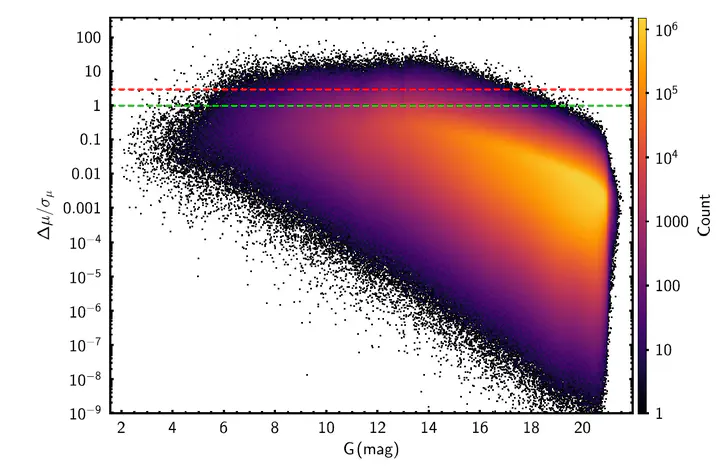Secular aberration drift in stellar proper motions — An additional term due to the change in line-of-sight direction
 Distribution of the additional proper motion due to secular aberration drift (Liu et al. 2024, A&A 688, L24)
Distribution of the additional proper motion due to secular aberration drift (Liu et al. 2024, A&A 688, L24)Abstract
The motion of the Solar System barycenter (SSB) induces a systematic effect known as the secular aberration drift, a key factor in high-precision astrometry. In this study, we identify and quantify an additional component of this drift resulting from the change in the line-of-sight direction caused by stellar proper motion. Using Gaia Data Release 3, we show that this effect alters the observed proper motion field of stars, decreasing it for Galactic longitudes 0°–180° and increasing it elsewhere. For 84 stars, the induced additional proper motion exceeds 1 mas yr⁻¹, and for nearly 6 million stars it exceeds 0.02 mas yr⁻¹—comparable to Gaia’s formal uncertainties for bright stars (G < 13). We recommend modeling both the SSB acceleration and this new term to ensure full consistency between the stellar and extragalactic reference frames.
The secular aberration drift is a systematic apparent motion in celestial reference frames caused by the non-uniform movement of the Solar System barycenter (SSB) within the Galaxy. While its component arising from Galactocentric acceleration has been incorporated in the construction of the third International Celestial Reference Frame (ICRF3), this study reveals an additional drift term produced by the change in the line-of-sight direction for stars with significant proper motion:contentReference[oaicite:0]{index=0}.
Using Gaia Data Release 3 (DR3), Liu et al. (2024) derived a complete analytical formula for the effect and computed its influence across more than 1.4 billion stars. The new term introduces systematic corrections to observed proper motions:
- decreases them for stars with Galactic longitudes between 0° and 180°,
- increases them for stars between 180° and 360°.
For 84 high-proper-motion stars (e.g., Barnard’s star, 61 Cyg A/B), the bias exceeds 1 mas yr⁻¹; for nearly 6 million stars, it exceeds 0.02 mas yr⁻¹, the order of Gaia’s formal uncertainty at G < 13. Future Gaia releases—expected to improve precision by a factor ≥ 0.35—will make this correction even more essential.
This additional secular aberration term should therefore be modeled jointly with the classical acceleration-induced component to maintain consistency between the stellar and extragalactic reference frames, reinforcing the conceptual foundation of the International Celestial Reference System (ICRS).
Citation:
Liu, N., Zhu, Z., & Liu, J.-C. (2024). Secular aberration drift in stellar proper motions — An additional term due to the change in line-of-sight direction. Astronomy & Astrophysics, 688, L24. https://doi.org/10.1051/0004-6361/202451053